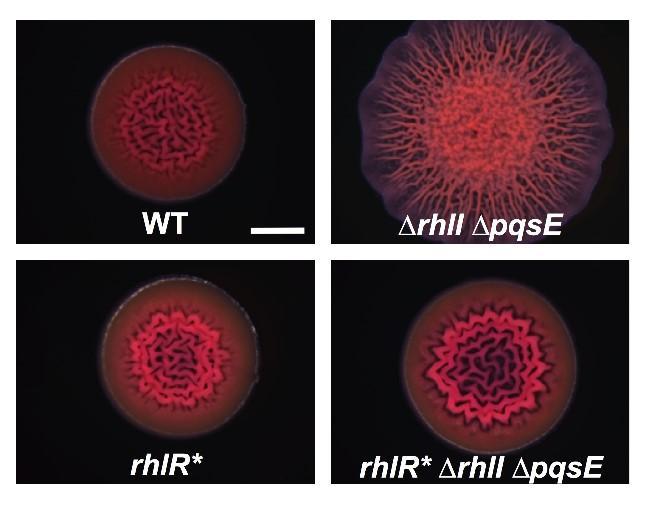
Credit: McCready AR, et al. (2019)
Researchers have developed a new mutant version of a receptor used by a bacterial pathogen for a chemical communication process called quorum sensing, according to a study published June 13 in the open-access journal PLOS Pathogens by Bonnie Bassler of Princeton University, and colleagues. As the authors note, the mutant receptor could be used to identify therapeutic compounds that inhibit quorum sensing, fulfilling an urgent medical need.
The human pathogen Pseudomonas aeruginosa uses quorum sensing to orchestrate group behaviors, including biofilm formation and the production of infection-promoting molecules called virulence factors. Quorum sensing, which is essential for P. aeruginosa to be a pathogen, relies on the production, release, and detection of extracellular signal molecules called autoinducers. Autoinducers are bound by partner receptor proteins, and together, autoinducer-receptor complexes activate the transcription of quorum-sensing genes. In the new study, Bassler and colleagues identify, purify, and characterize a mutant version of the P. aeruginosa RhlR quorum-sensing receptor, which they call RhlR*.
Remarkably, RhlR* does not require its partner autoinducer to function. P. aeruginosa carrying RhlR* can properly form biofilms, produce virulence factors, and infect roundworms. Because RhlR* does not rely on an autoinducer to function, biochemical and genetic analyses that were previously not possible with RhlR could be performed with RhlR*. The findings provide new insight into the workings of other P. aeruginosa quorum-sensing components, most notably, the PqsE enzyme that functions together with RhlR to control virulence factor production. The authors propose that RhlR* is an especially valuable tool for learning about cell-cell communication and virulence in P. aeruginosa, a pathogen of high clinical relevance.
The authors add, “To our knowledge, this is the first report of a quorum-sensing receptor of this class that functions without its partner autoinducer molecule, opening up entirely new possibilities for study of virulence in Pseudomonas aeruginosa, a globally important pathogen.”
###
Research Article
Funding: This work was supported by the Howard Hughes Medical Institute, National Institutes of Health Grant 5R37GM065859, National Science Foundation Grant MCB-1713731 (B.L.B.), NIGMS T32GM007388 (A.R.M.), and a Jane Coffin Childs Memorial Fund for Biomedical Research Postdoctoral Fellowship (J.E.P.). The authors declare that they have no conflicts of interest with the contents of this article. The content is solely the responsibility of the authors and does not necessarily represent the official views of the National Institute of Health. The funders had no role in study design, data collection and analysis, decision to publish, or preparation of the manuscript.
Competing Interests: No. The authors have declared that no competing interests exist.
Citation: McCready AR, Paczkowski JE, Cong J-P, Bassler BL (2019) An autoinducer-independent RhlR quorum-sensing receptor enables analysis of RhlR regulation. PLoS Pathog 15(6): e1007820. https:/
Author Affiliations:
Princeton University
In your coverage please use this URL to provide access to the freely available paper: http://journals.
Media Contact
Bonnie Bassler
[email protected]
Related Journal Article
http://dx.





